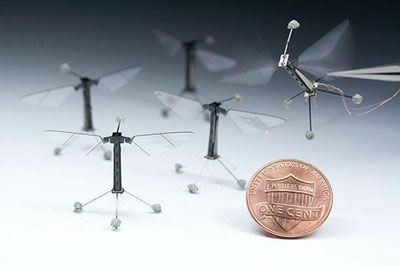Applications of the RoboBee project could include distributed environmental monitoring, search-and-rescue operations, or assistance with crop pollination.
However, the materials, fabrication techniques and components that emerge along the way might prove to be even more significant.
For example, the pop-up manufacturing process could enable a new class of complex medical devices.
Harvard’s Office of Technology Development, in collaboration with Harvard SEAS and the Wyss Institute, is already in the process of commercialising some of the underlying technologies.
“Harnessing biology to solve real-world problems is what the Wyss Institute is all about,” says Wyss Founding Director Don Ingber. “This work is a beautiful example of how bringing together scientists and engineers from multiple disciplines to carry out research inspired by nature and focused on translation can lead to major technical breakthroughs.”
And the project continues
“Now that we’ve got this unique platform, there are dozens of tests that we’re starting to do, including more aggressive control manoeuvres and landing,” says Wood.
After that, the next steps will involve integrating the parallel work of many different research teams who are working on the brain, the colony coordination behaviour, the power source and so on, until the robotic insects are fully autonomous and wireless.
Still tethered
The prototypes are still tethered by a very thin power cable because there are no off-the-shelf solutions for energy storage that are small enough to be mounted on the robot’s body.
High energy-density fuel cells must be developed before the RoboBees will be able to fly with much independence.
Control, too, is still wired in from a separate computer, though a team led by SEAS faculty Gu-Yeon Wei and David Brooks is working on a computationally efficient brain that can be mounted on the robot’s frame.
“Flies perform some of the most amazing aerobatics in nature using only tiny brains,” notes co-author Sawyer B Fuller, a postdoctoral researcher on Wood’s team who essentially studies how fruit flies cope with windy days.
“Their capabilities exceed what we can do with our robot, so we would like to understand their biology better and apply it to our own work.”
The power of ambitious dreams
The milestone of this first controlled flight represents a validation of the power of ambitious dreams—especially for Wood, who was in graduate school when he set this goal.
“This project provides a common motivation for scientists and engineers across the university to build smaller batteries, to design more efficient control systems and to create stronger, more lightweight materials,” says Wood.
“You might not expect all of these people to work together: vision experts, biologists, materials scientists, electrical engineers. What do they have in common? Well, they all enjoy solving really hard problems.”
“I want to create something the world has never seen before,” adds Ma. “It’s about the excitement of pushing the limits of what we think we can do, the limits of human ingenuity.”
A video of RoboBee’s flight is available on YouTube.
See this article in Tree Fruit December 2013






















